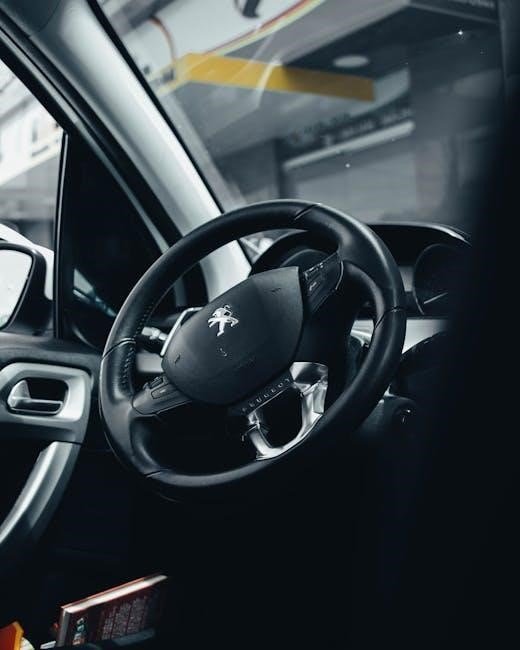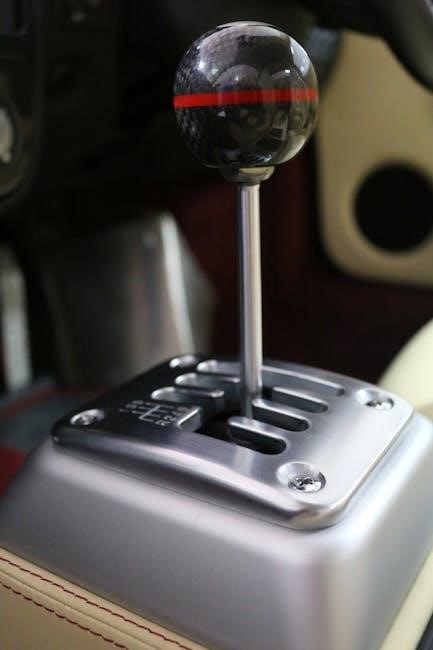A multimeter is an essential tool for measuring electrical parameters like voltage‚ current‚ and resistance. Modern multimeters offer two modes: auto-ranging and manual-ranging. While auto-ranging provides simplicity and speed for beginners‚ manual-ranging offers precision for professionals. This guide explores their differences‚ benefits‚ and applications‚ helping you choose the right tool for your needs.
What is a Multimeter?
A multimeter is an electronic device designed to measure various electrical parameters such as voltage‚ current‚ resistance‚ and continuity. It combines multiple measurement functions in one unit‚ making it versatile for diagnosing and testing electrical circuits. Modern multimeters feature digital displays (LCD or LED) for precise readings and often include advanced functions like auto-ranging‚ data hold‚ and low battery indication. Whether in auto-ranging or manual-ranging mode‚ a multimeter is an indispensable tool for professionals and DIY enthusiasts‚ ensuring accurate and efficient electrical measurements across diverse applications.
Importance of Multimeters in Electrical Measurements
A multimeter is a crucial tool for ensuring safety‚ accuracy‚ and efficiency in electrical measurements. It allows users to diagnose faults‚ verify circuit performance‚ and measure parameters like voltage‚ current‚ and resistance. Whether in auto-ranging or manual-ranging mode‚ multimeters provide precise data‚ enabling professionals and DIY enthusiasts to troubleshoot issues effectively. Their versatility across industries‚ from electronics to automotive‚ makes them indispensable for maintaining electrical systems and ensuring compliance with safety standards. Reliable multimeters are essential for achieving accurate results in both professional and amateur electrical work.
Brief History and Evolution of Multimeters
The multimeter traces its origins to the 1920s‚ evolving from separate voltage‚ current‚ and resistance meters. The first digital multimeters emerged in the 1970s‚ offering greater accuracy. The 1990s introduced auto-ranging‚ simplifying use. Modern multimeters integrate advanced features like Bluetooth connectivity‚ mobile app support‚ and AI-driven automation. This evolution reflects technological advancements‚ catering to both professionals and hobbyists. The transition from manual to smart multimeters highlights the industry’s commitment to innovation‚ ensuring precise and efficient electrical measurements across various applications.

Understanding Auto Ranging Multimeters
Auto ranging multimeters automatically adjust measurement ranges‚ offering simplicity and efficiency. They suit beginners and quick tasks‚ eliminating manual range selection. Their convenience enhances productivity and ease of use.
What is Auto Ranging?
Auto ranging is a feature in multimeters that automatically selects the appropriate measurement range based on the input signal; This eliminates the need for manual range selection‚ simplifying the process and reducing measurement time. Auto-ranging multimeters quickly adjust to the detected voltage‚ current‚ or resistance levels‚ ensuring accurate readings without user intervention. This feature is particularly useful for beginners or when dealing with unknown values‚ as it minimizes errors and enhances efficiency in various electrical tasks.
How Auto Ranging Works
Auto ranging operates by automatically detecting the input signal’s magnitude and adjusting the measurement range accordingly. When a measurement is initiated‚ the multimeter quickly assesses the signal and selects the most suitable range to ensure precise readings. This process happens internally‚ eliminating the need for manual adjustments. The multimeter’s microprocessor handles the range selection‚ displaying the result on the LCD screen. This seamless functionality ensures accurate and efficient measurements‚ making it ideal for users who prioritize speed and convenience in their electrical tasks and diagnostics.
Advantages of Auto Ranging Multimeters
Auto ranging multimeters offer unparalleled convenience and efficiency‚ automatically selecting the optimal measurement range for accurate readings. This eliminates the need for manual adjustments‚ saving time and reducing the risk of human error. Ideal for beginners‚ they provide quick‚ straightforward measurements without requiring extensive technical knowledge. Additionally‚ auto ranging multimeters adapt seamlessly to varying input signals‚ ensuring precise results across different scenarios. Their ease of use and speed make them a preferred choice for professionals and DIY enthusiasts alike‚ especially in fast-paced environments where efficiency is crucial.
Disadvantages of Auto Ranging Multimeters
Auto ranging multimeters have higher initial costs compared to manual models‚ making them less accessible for budget-conscious users. They also lack the precision control offered by manual ranging‚ which can be problematic for professionals needing exact measurements. Additionally‚ auto ranging multimeters may experience delays in settling on the correct range‚ especially with fluctuating signals. While convenient‚ they rely on internal algorithms that may not always select the optimal range‚ potentially leading to inaccuracies in complex or unstable circuits. These limitations make manual ranging a better choice for advanced tasks requiring precise control and reliability.

Understanding Manual Ranging Multimeters
Manual ranging multimeters require users to set the measurement range themselves‚ offering precise control over measurements. This setup is ideal for professionals needing exact readings in complex circuits. While they lack the convenience of auto-ranging‚ manual models are often more affordable and provide reliability for advanced tasks. However‚ they demand a good understanding of electrical parameters to select the correct range‚ which can be time-consuming for beginners. Despite this‚ manual ranging remains a preferred choice for scenarios where accuracy and control are paramount.
What is Manual Ranging?
Manual ranging refers to a multimeter mode where the user manually selects the measurement range before taking readings. This involves choosing the appropriate voltage‚ current‚ or resistance scale to ensure accurate results. Unlike auto-ranging‚ which automatically adjusts the range‚ manual ranging requires the user to have prior knowledge of the expected measurement values. This method provides precise control and is often preferred in professional settings where specific measurements are critical. It also avoids the potential delays caused by auto-ranging adjustments‚ making it ideal for tasks requiring immediate and exact data.
How Manual Ranging Works
Manual ranging requires the user to select the measurement range using a dial or buttons before taking a reading. The multimeter remains in the chosen range until manually adjusted. This process involves selecting the appropriate scale for voltage‚ current‚ or resistance based on the expected value. If the range is too low‚ an overflow error may occur‚ necessitating a higher range selection. Manual ranging provides direct control and avoids automatic adjustments‚ making it suitable for precise measurements. However‚ it demands user expertise and prior knowledge of the expected measurement range to ensure accuracy and reliability.
Advantages of Manual Ranging Multimeters
Manual ranging multimeters offer precise control‚ allowing users to select specific measurement ranges for accuracy. They are ideal for professionals needing exact values in complex tasks. With manual adjustment‚ there’s no risk of automatic range shifting during critical measurements. This feature is crucial in professional settings where stability and reliability are paramount. Additionally‚ manual ranging often costs less than auto-ranging models‚ making them a cost-effective choice for experts who value precision over convenience. The ability to fine-tune measurements ensures better accuracy for specialized tasks‚ making manual multimeters a preferred tool in technical environments.
Disadvantages of Manual Ranging Multimeters
Manual ranging multimeters require users to set the range manually‚ which can be time-consuming and inconvenient. This process demands prior knowledge of the expected measurement range‚ as incorrect settings may lead to inaccuracies. Additionally‚ manual adjustment can be error-prone‚ especially for beginners‚ and lacks the speed and efficiency of auto-ranging models. The need for expertise to operate effectively makes manual multimeters less accessible to new users. Furthermore‚ without automation‚ manual ranging can be less efficient in dynamic or high-pressure environments where quick measurements are essential.

Auto Ranging vs. Manual Ranging: Key Differences
Auto-ranging multimeters automatically adjust measurement ranges for convenience and speed‚ while manual ranging requires user input‚ offering precision but lacking efficiency for quick measurements.
Difference in Ease of Use
Auto-ranging multimeters are more user-friendly‚ especially for beginners‚ as they automatically select the appropriate range for measurements‚ eliminating the need for manual adjustments. This simplicity reduces errors and saves time. Manual-ranging multimeters‚ however‚ require users to select the range themselves‚ which can be complex for those unfamiliar with electrical measurements. While manual-ranging offers more control‚ it demands a higher level of expertise and can be time-consuming. Thus‚ auto-ranging is ideal for simplicity and convenience‚ while manual-ranging suits professionals needing precise control over measurements.
Difference in Measurement Speed
Auto-ranging multimeters are significantly faster in measurement tasks due to their ability to automatically adjust to the correct range‚ enabling quick readings without manual intervention. This makes them ideal for tasks requiring efficiency. Manual-ranging multimeters‚ however‚ require users to manually select the appropriate range‚ which can delay the measurement process‚ especially for those unfamiliar with the expected range. While manual-ranging offers precision‚ it sacrifices speed‚ making auto-ranging the preferred choice for rapid and straightforward measurements.
Difference in Cost
Auto-ranging multimeters are generally more expensive than manual-ranging models due to their advanced features and automation capabilities. The added convenience and speed come at a higher initial cost‚ making them less accessible for budget-conscious users. Manual-ranging multimeters‚ while lacking automation‚ are often more affordable and provide a cost-effective solution for those who prioritize precision and are willing to invest time in manual adjustments. The price difference reflects the trade-off between convenience and cost‚ catering to different user preferences and financial constraints.
Difference in Precision and Control
Auto-ranging multimeters offer convenience but may lack the precision of manual-ranging models. While auto-ranging automatically selects the range‚ manual-ranging allows users to set the range manually‚ providing finer control over measurements. This makes manual-ranging multimeters more suitable for tasks requiring high precision‚ such as professional or specialized electrical work. However‚ auto-ranging multimeters are sufficient for general-purpose measurements and are easier to use for beginners. The trade-off lies in the balance between ease of use and the need for exact control over measurement parameters.
Difference in User Expertise Required
Auto-ranging multimeters are more beginner-friendly‚ requiring minimal user expertise. They automatically adjust settings‚ simplifying the measurement process. Manual-ranging multimeters‚ however‚ demand a higher level of technical knowledge. Users must understand electrical parameters and manually select appropriate ranges‚ which can be challenging for novices. Professionals often prefer manual-ranging for its control‚ but it assumes familiarity with electrical measurements. Auto-ranging is ideal for simplicity‚ while manual-ranging suits those with expertise‚ ensuring precise and accurate results in complex tasks.

Technical Specifications and Features
Auto-ranging multimeters feature LCD displays‚ data hold‚ and low battery indicators for ease. Manual-ranging models offer precision and control‚ ideal for professional use. Both ensure accurate measurements.
Display Types: LCD vs. LED
Modern multimeters feature either LCD or LED displays. LCD screens offer higher resolution‚ color backlighting‚ and better readability in low light. LED displays are simpler‚ often single-color‚ and more common in manual-ranging models. LCD displays‚ like those in auto-ranging multimeters‚ provide clearer numerical readings and additional information such as icons for active functions. LED displays‚ while less advanced‚ are reliable and energy-efficient‚ making them suitable for basic measurements. The choice between LCD and LED depends on the user’s need for advanced features versus simplicity and cost-effectiveness.
Measurement Ranges: Voltage‚ Current‚ Resistance
Multimeters measure voltage‚ current‚ and resistance with varying ranges. Auto-ranging models automatically adjust to the input signal‚ offering a wide range of measurements without manual selection. Manual-ranging multimeters require users to select the appropriate range for accurate readings. Most multimeters measure DC/AC voltage (0-1000V)‚ current (mA to A)‚ and resistance (ohms). The auto-ranging feature simplifies usage for beginners‚ while manual-ranging provides precision for professionals. Understanding these ranges is crucial for accurate electrical measurements‚ ensuring safety and reliability in both DIY and professional settings.
Additional Features: Data Hold‚ Low Battery Indication‚ Auto Power-Off
Modern multimeters often include practical features like data hold‚ which freezes measurements for easy reading‚ and low battery indication‚ ensuring timely replacements. Auto power-off conserves battery life by turning the device off after inactivity. These features enhance user convenience without affecting the core functionality of auto-ranging or manual-ranging modes. They are particularly useful for beginners and professionals alike‚ providing a seamless and efficient measurement experience while extending the multimeter’s operational lifespan. These additions make multimeters more user-friendly and reliable in various applications.
Specialized Measurements: Temperature‚ Frequency‚ Duty Cycle
Advanced multimeters often include temperature‚ frequency‚ and duty cycle measurements‚ catering to specific industrial and automotive needs. Temperature measurement is useful for monitoring heating components‚ while frequency measurement aids in analyzing signal waveforms. Duty cycle measurement is essential for assessing pulse-width modulation signals. These specialized functions enhance the versatility of both auto-ranging and manual-ranging multimeters‚ making them indispensable for professionals requiring precise data in complex electrical systems. These features ensure accurate diagnostics and troubleshooting in demanding environments‚ showcasing the multimeter’s adaptability beyond basic electrical measurements.

Practical Applications and Use Cases
Auto-ranging multimeters excel in DIY projects and beginner tasks due to their simplicity‚ while manual-ranging multimeters are ideal for professionals requiring precise control in complex electrical systems.
Auto Ranging Multimeters in DIY Projects
Auto-ranging multimeters are a perfect fit for DIY enthusiasts‚ offering ease of use and quick measurements. Their ability to automatically adjust ranges simplifies troubleshooting and reduces errors‚ making them ideal for home repairs and electronics projects. Beginners benefit from the streamlined process‚ focusing on tasks without manual range adjustments. Additionally‚ features like data hold and auto power-off enhance convenience‚ ensuring efficient and safe operation in various DIY settings.
Manual Ranging Multimeters in Professional Settings
Manual-ranging multimeters are preferred in professional environments where precision and control are critical. By allowing users to select specific ranges‚ these tools enable accurate measurements tailored to the task. Professionals‚ such as engineers and technicians‚ value the ability to fine-tune settings‚ ensuring reliable results in complex projects. While they may require more expertise‚ manual-ranging multimeters deliver the exactness needed for specialized applications‚ making them indispensable in industries demanding high-precision electrical measurements and diagnostics.
Using Auto Ranging for Beginners
Auto-ranging multimeters are ideal for beginners due to their simplicity and ease of use. They automatically adjust to the appropriate range for the measurement‚ eliminating the need for manual adjustments. This feature reduces errors and allows users to focus on the task at hand. For those new to electrical measurements‚ auto-ranging multimeters provide quick and accurate results without requiring an understanding of range selection. They are perfect for DIY projects and straightforward measurements‚ making them an excellent choice for anyone looking to learn without the complexity of manual controls.
Using Manual Ranging for Precision Tasks
Manual ranging multimeters are preferred for precision tasks‚ offering greater control over measurements. Professionals often choose this mode to set specific ranges‚ ensuring accuracy in complex or sensitive applications. While it requires more expertise‚ manual ranging allows for finer adjustments and avoids potential errors caused by automatic range selection. This makes it ideal for specialized electrical work where precise readings are critical. The ability to override auto settings gives users confidence in their measurements‚ making manual ranging a valuable tool in professional and high-stakes environments.

Future Trends in Multimeter Technology
Future multimeters will feature advanced automation‚ AI integration‚ and smart connectivity. Expect enhanced precision‚ real-time data sharing‚ and user-friendly interfaces‚ revolutionizing electrical measurements for professionals and DIYers.
Smart Multimeters and Connectivity Options
Smart multimeters are revolutionizing electrical measurements with advanced connectivity features. These devices can connect to smartphones and tablets via Bluetooth or Wi-Fi‚ enabling real-time data sharing and remote monitoring. With dedicated mobile apps‚ users can store‚ analyze‚ and export measurements effortlessly. This seamless integration enhances collaboration and streamlines workflows for both professionals and DIY enthusiasts. Additionally‚ smart multimeters often include cloud storage options‚ allowing data to be accessed from anywhere‚ making them indispensable tools in modern electrical work.
Integration with Mobile Apps and Software
Modern multimeters now integrate seamlessly with mobile apps and software‚ enhancing their functionality. By connecting via Bluetooth or Wi-Fi‚ users can transmit measurements directly to smartphones or tablets. Mobile apps enable real-time data logging‚ graphing‚ and analysis‚ making it easier to track trends and generate reports. Some apps even offer guided measurements‚ helping beginners use their multimeters effectively. For professionals‚ this integration allows advanced data analysis and remote monitoring‚ streamlining workflows and improving accuracy. This connectivity bridges the gap between handheld tools and digital systems‚ offering unparalleled convenience and efficiency for both auto-ranging and manual multimeters.
Advanced Automation and AI in Multimeters
Future multimeters are leveraging advanced automation and AI to enhance functionality. AI-driven algorithms can automatically detect measurement types and adjust settings‚ reducing human error. Predictive maintenance features use AI to analyze data and forecast potential circuit failures. Automation also enables faster and more accurate measurements‚ especially in complex systems. These innovations simplify troubleshooting and improve efficiency‚ making multimeters indispensable for both auto-ranging and manual operations. The integration of AI ensures smarter‚ more reliable tools for professionals and beginners alike‚ setting a new standard in electrical measurement technology.

How to Choose the Right Multimeter
Choosing the right multimeter depends on your measurement needs and skill level. Auto-ranging is ideal for simplicity‚ while manual offers precision for professionals. Consider your budget‚ desired features‚ and expertise to make the best choice.
Assessing Your Measurement Needs
Evaluate your specific requirements to determine the best multimeter for your tasks. Consider the types of measurements you’ll perform most frequently‚ such as voltage‚ current‚ or resistance. Think about the precision and speed needed for your work. If you prioritize ease and quick results‚ auto-ranging may be ideal. For precise control over measurements‚ manual-ranging could be more suitable. Additionally‚ reflect on your expertise level and the complexity of your projects. Understanding your needs will help you select a multimeter that aligns with your workflow and ensures accurate results.
Considering Budget and Value
Budget plays a crucial role in selecting a multimeter. Auto-ranging models are generally more expensive due to their advanced features and convenience. Manual-ranging multimeters‚ while often more affordable‚ require more expertise. Evaluate the value each option offers for your specific needs. If speed and simplicity are priorities‚ the higher cost of an auto-ranging multimeter may be justified. For precise control and lower costs‚ manual-ranging could provide better value. Additionally‚ consider the durability and brand reputation‚ as these factors often correlate with long-term performance and reliability‚ ensuring your investment aligns with your professional or personal requirements.
Evaluating Brand and Quality
When choosing a multimeter‚ brand and quality are critical factors. Reputable brands like Fluke‚ Keysight‚ and Amprobe are known for their durability and accuracy. While cheaper alternatives may exist‚ they often lack the reliability and precision of established brands. Consider the build quality‚ display clarity‚ and additional features like backlighting or data hold. High-quality multimeters‚ whether auto-ranging or manual‚ ensure consistent performance and longevity. Prioritizing a trusted brand may mean a higher upfront cost but guarantees better reliability and accuracy for both casual and professional use‚ making it a worthwhile investment in the long run.
Reading User Reviews and Ratings
Reading user reviews and ratings is crucial for selecting the right multimeter. Real-world feedback highlights pros and cons‚ such as ease of use‚ accuracy‚ and durability. Users often praise auto-ranging multimeters for their simplicity‚ while manual-ranging models are favored for precision. Pay attention to reviews from professionals and beginners to gauge performance in different scenarios. Be cautious of biased or fake reviews by cross-referencing multiple sources. Prioritize reviews that discuss specific features‚ like display clarity or additional functions‚ to make an informed decision tailored to your needs and expertise level.

Frequently Asked Questions (FAQs)
- What is the effect of choosing auto or manual range?
- Can auto-ranging multimeters be used manually?
- How do I calibrate my multimeter?
- What is the best multimeter for beginners?
What is the Effect of Choosing Auto or Manual Range?
Choosing between auto-ranging and manual-ranging affects measurement speed and convenience. Auto-ranging automatically selects the best range‚ saving time and reducing errors‚ ideal for beginners. Manual-ranging requires users to set the range‚ offering precision for professionals. The primary difference lies in measurement speed: auto-ranging is faster but may lack the control needed for complex tasks. Manual-ranging provides accuracy but demands more expertise. The choice depends on user skill level and specific requirements‚ ensuring optimal results in electrical measurements.
Can Auto Ranging Multimeters be Used Manually?
Yes‚ many auto-ranging multimeters can be used manually by overriding the automatic range selection. This feature allows users to switch between auto and manual modes‚ offering flexibility. Professionals often appreciate this option for precise measurements‚ while beginners may prefer the simplicity of auto-ranging. The ability to toggle modes depends on the multimeter’s design and features‚ making it suitable for a range of applications and user expertise levels. This dual functionality enhances the tool’s versatility in various electrical measurement scenarios;
How Do I Calibrate My Multimeter?
Calibrating a multimeter ensures accurate measurements. Start by turning it on and selecting the desired mode (voltage‚ current‚ or resistance). Use the calibration ports or built-in procedures‚ often involving shorting terminals or using specific resistors. Adjust the multimeter according to the manufacturer’s instructions to match reference values. Regular calibration is essential for maintaining precision‚ especially in professional settings. Always refer to the user manual for specific calibration steps‚ as procedures may vary between models. Proper calibration enhances reliability and ensures consistent results in electrical measurements.

What is the Best Multimeter for Beginners?
The best multimeter for beginners is one with auto-ranging capabilities‚ as it simplifies operation by automatically selecting the appropriate range. Look for models with a clear LCD display‚ data hold‚ and low battery indication. Safety features like overload protection and CAT III/CAT IV ratings are essential. Beginner-friendly multimeters often include basic functions like voltage‚ current‚ and resistance measurement. Popular brands such as Fluke‚ Etekcity‚ or Mastech offer reliable options. Choose a model with good user reviews and a reasonable price point to ensure ease of use and value for money.
Auto-ranging multimeters offer simplicity and speed‚ ideal for beginners‚ while manual-ranging models provide precision for professionals. Choose based on your expertise and measurement needs for optimal results.
Final Thoughts on Auto Ranging vs. Manual Multimeters
Auto-ranging multimeters excel in simplicity and speed‚ making them ideal for beginners or quick measurements. Manual-ranging models‚ however‚ offer precision and control‚ catering to professionals. While auto-ranging is more convenient‚ manual-ranging provides better accuracy for complex tasks. Budget considerations also play a role‚ as auto-ranging models are generally more expensive. Ultimately‚ the choice depends on the user’s expertise and specific needs. For casual use‚ auto-ranging is recommended‚ while professionals may prefer manual-ranging for precise control over measurements.
Recommendations for Different User Types
For beginners‚ auto-ranging multimeters are ideal due to their ease of use and automatic range selection‚ ensuring quick and accurate measurements without complexity. Professionals may prefer manual-ranging models for precise control over measurements‚ especially in specialized tasks. Hobbyists and DIY enthusiasts can benefit from auto-ranging for simplicity‚ while those needing high accuracy might opt for manual-ranging. Budget-conscious users should consider manual models‚ as they are often more affordable. Ultimately‚ the choice depends on the user’s skill level‚ measurement needs‚ and budget constraints.
